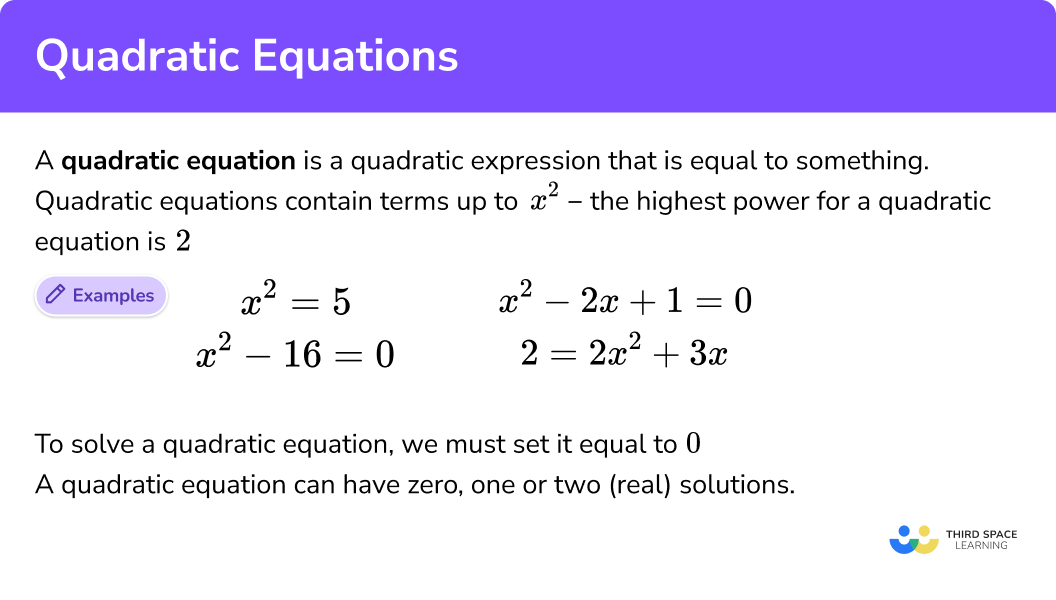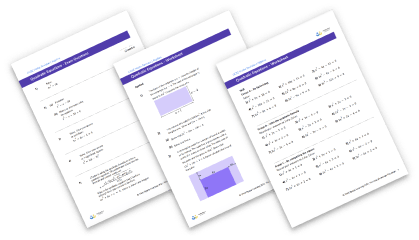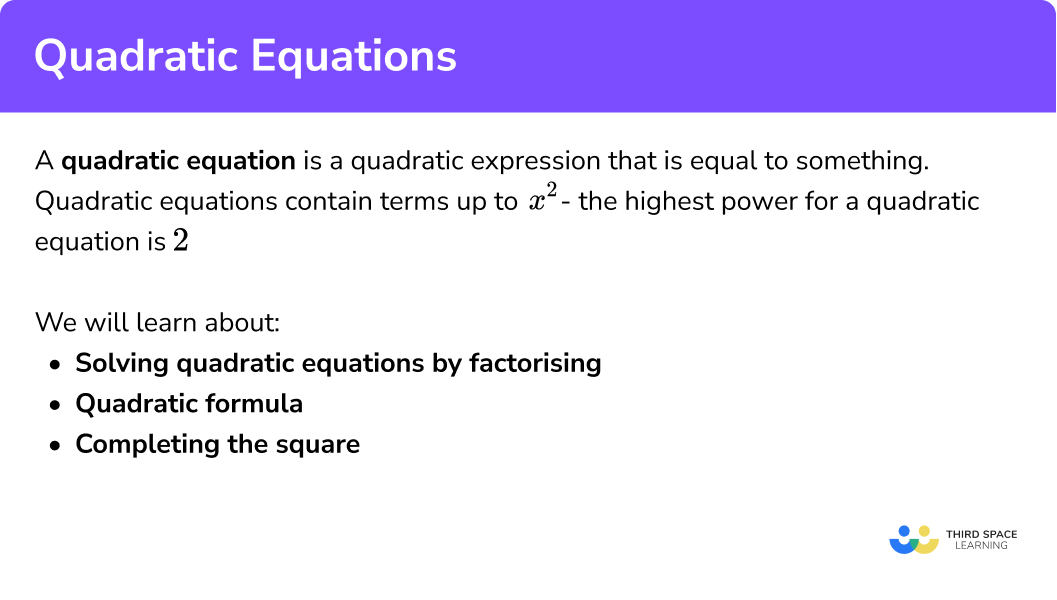GCSE Tutoring Programme
Our chosen students improved 1.19 of a grade on average - 0.45 more than those who didn't have the tutoring.
In order to access this I need to be confident with:
Factorising quadratics Expanding brackets Simplifying algebraic expressionsThis topic is relevant for:

Quadratic Equation
Here we will learn about the quadratic equation and how to solve quadratic equations using four methods: factorisation, using the quadratic equation formula, completing the square and using a graph.
There are also quadratic equation worksheets based on Edexcel, AQA and OCR exam questions, along with further guidance on where to go next if you’re still stuck.
What is a quadratic equation?
A quadratic equation is a quadratic expression that is equal to something. It is an equation of the general form,
Quadratic algebraic equations are equations that contain terms up to
Quadratic equations are a type of polynomial equation because they consist of two or more algebraic terms.
To solve a quadratic equation it must equal 0.
Example:
A quadratic equation can have zero, one or two (real) solutions.
The general example of a quadratic equation formula is written as:
At GCSE the solutions to polynomial equations such as quadratics will always give real numbers but they can be either irrational and rational numbers.
What is a quadratic equation?


Quadratic equation worksheet

Get your free quadratic equation worksheet of 20+ questions and answers. Includes reasoning and applied questions.
DOWNLOAD FREE
Quadratic equation worksheet

Get your free quadratic equation worksheet of 20+ questions and answers. Includes reasoning and applied questions.
DOWNLOAD FREEHow to solve a quadratic equation
In order to solve a quadratic equation we must first check that it is in the form:
If it isn’t, we will need to rearrange the equation.
Example:
Explain how to solve a quadratic equation

Ways of solving quadratic equations
Although the most common way of solving quadratic equations is through factorising, there are in fact three other ways to solve them as well. We will explore how to solve the same quadratic equation in each of the four ways.
Step-by-step guide: Solving equations
a) Factorisation
Example of solving a quadratic equation by factorisation:
Solve
Step-by-step guide: Solving quadratic equations by factorising
b) Quadratic formula (H)
Example of solving a quadratic equation by using the quadratic formula:
Solve
The standard form of a quadratic equation is given by
Step-by-step guide: Quadratic formula
c) Completing the square (H)
Example of solving a quadratic equation by completing the square
Solve
Step-by-step guide: Completing the square
d) Quadratic graphs
Example of solving a quadratic equation by using a quadratic graph
Solve
The real roots/solutions are shown where the graph crosses the horizontal x-axis.
Step-by-step guide: Quadratic graphs
Quadratic equation examples
Example 1: quadratic equation – solve by factorising
Example of solving a quadratic equation by factorising (also known as factoring).
To solve
- Fully factorise the quadratic equation.
We can factorise a quadratic into two brackets when it is in the form
Factors
1, 24
2, 12
3, 8
4, 6
2 Set each bracket equal to 0.
3 Solve each equation to find
We can check that our solution is correct by substituting it into the original equation.
Example 2: quadratic equation – solve by using the quadratic formula
Example of solving a quadratic equation by using the quadratic formula.
To solve
- Identify the a, b and c.
2 Substitute the these values into the quadratic formula.
The
part of the quadratic formula is called the discriminant and tells us how many real roots (solutions) the equation has.
Using brackets will help to make the calculation clear.
3 Use a calculator to solve the equation with a +, and then with a −.
We can check that our solution is correct by substituting it into the original equation.
Example 3: quadratic equation – solve by completing the square
Example of solving a quadratic equation by completing the square.
To solve
- Complete the square to rewrite the quadratic equation in the form
a(x + d)2 + e = 0 .
2 Rearrange the equation to work out the unknown variable
The opposite of − 25 is + 25, so + 25 to both sides of the equation.
The opposite of squaring is square root, so take the square root of the left hand side, and the right hand side.
Remember a square root has a positive and a negative solution, so use the ± sign.
3 The square root has a + and – answer, write down both versions of the calculation to find the two solutions of
We can check that our solution is correct by substituting it into the original equation.
Example 4: quadratic equation – solve by drawing a graph
We can plot a quadratic equation to form a quadratic graph to help us to solve it.
We can substitute values for
Example of solving a quadratic equation by drawing the graph:
To solve
we need to:
- Draw the quadratic graph
2 The solutions/roots of equation are where the graph crosses the
We know that to solve a quadratic it must be equal to 0.
Because
On the graph the coordinates for
So the solutions or roots of the equation
are
We can check that our solution is correct by substituting it into the original equation.
Step-by-step guide: Solving quadratic equations graphically
Quadratic equation questions
Solve the following by either using factorising, the quadratic formula, or completing the square. What would the quadratic graph look like?
1. Solve:
{x}^2+x-6=0




can be factorised as
(x+3)(x-2)=0
By setting each bracket equal to zero and solving, we get the required solutions.
2. Solve:
{x}^2-4x-1=0




This quadratic equation cannot be factorised so we need to use the quadratic formula with a=1, \; b=-4 and c=-1 . Be careful when substituting negative numbers; the signs are important.
3. Solve:
2{x}^2-7x+6=0




can be factorised as
(2x-3)(x-2)=0
By setting each bracket equal to zero and solving, we get the required solutions.
4. Solve:
3{x}^2+5x-2=0




can be factorised as
(3x-1)(x+2)=0
By setting each bracket equal to zero and solving, we get the required solutions.
Quadratic equation questions for GCSE
1. (a) Factorise
x^{2}-x-30
(2 marks)
(x + 5) or (x – 6)
(1)
(x + 5) (x – 6)
(1)
1. (b) Hence or otherwise solve the equation
x^{2}-x-30=0
(1 mark)
x = -5 or x = 6
(1)
2. Solve
2 x^{2}+10 x+12=0
(3 marks)
(2x + 4)(x + 3)
(1)
x = -3
(1)
x = -2
(1)
Did you know?
- Did you know that Al-Khwarizmi (Abu Ja’far Muhammad ibn Musa al-Khwarizmi) was one of the first people in history to write about algebra? He lived in Baghdad around 780 to 850 AD and his book “Hisab Al-jabr w’al-muqabala” is where we get the word ‘algebra’ (meaning ‘restoration of broken parts’).

- Did you know the ancient Babylonians could solve quadratic equations using a method equivalent to the quadratic formula, despite not using algebraic notation!
- Did you know that the ancient Greek mathematician Euclid used geometric methods to solve quadratic equations way back in 300BC! His book, The Elements, is one of the most studied books in human history.
The history of mathematics is amazing!
Learning checklist
You have now learned how to:
-
Solve quadratic equations algebraically by factorising
-
Solve quadratic equations algebraically by using the quadratic formula (H)
-
Solve quadratic equations algebraically by completing the square (H)
-
Solve quadratic equations by finding approximate solutions using a graph
The next lessons are
Still stuck?
Prepare your KS4 students for maths GCSEs success with Third Space Learning. Weekly online one to one GCSE maths revision lessons delivered by expert maths tutors.

Find out more about our GCSE maths tuition programme.